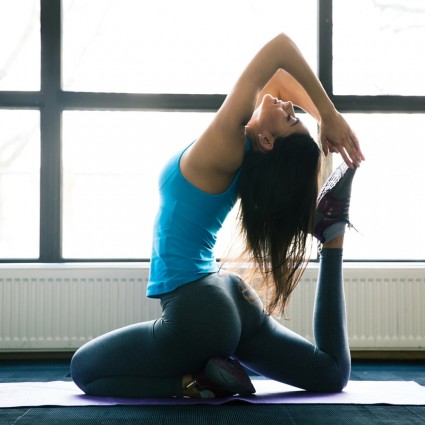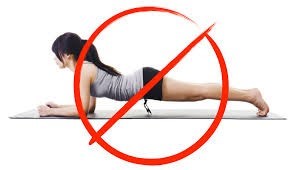What Do You Think About Yoga?

I think my back hurts…
At First My Mind is All Like:
“It’s a really good thing that teaches calmness, focus, controlled breathing and body awareness.”
But My Mouth Goes (after I give it some thought):
“You probably shouldn’t do it.”
Whaaaaaaaaaaaaaa???
Why I don’t recommend Yoga to most people.
From my experience, Americanized yoga, what you’d probably be doing, is usually a real Sh@t fest.
Full disclosure:
I’ve NEVER taken a Yoga Class.
For realzzzz
I know you’re mad right now.
You’re all like, “You’re such a hypocrite, I like yoga. It’s so kool. I’ve taught it for sooo long and it’s awesome and I’m awesome and you sucks”.
It’s K, I deal with this a lot.
Here’s the thing: I’ve worked in this industry a looong time now and have seen lots of yoga classes, trained a lot of people who took yoga religiously (this includes certified instructors) and ya know, movement is movement.
It doesn’t matter what you call it. All that matters is Anatomy, Physics and Biology.
I’ve also never driven my head through a wall, yet I KNOW that wouldn’t be a pleasant experience. <—-sometimes you don’t need to do something to know it’s not cool.
Gonna lay some heavy crap on ya right now.
The American version of Yoga, what you’re doing at that place in the strip mall next to Five Below and Cold Stone, aint really Yoga at all.
See real Yoga is mostly about the good stuff.
Calmness, controlling your breathing, learning to feel your muscles, control their actions, posture and owning your movement.
This stuff about putting your foot behind your head, $100 Lululemon pants and bitching about your husband and kids?
No so much.
Yoga postures have often been thought of as a form of exercise. But from an ancient perspective, they are not merely exercises, but techniques that place the physical body in positions that cultivate awareness, relaxation, concentration, and meditation.- Dhanya Fernando
My Gripes with the Strip Mall Yoga:
#1: Your joints are made to achieve a full range of motion.
Not an excessive range of motion.
Too much stretching can make a joint hypermobile, and that’s at least as problematic as a joint being tight and probably more so.
ligament laxity is usually the result of the joint being habitually loaded beyond its normal range of motion, which is what happens when we “flop into our joints” time-and-time again without muscular support.-Jenni Rawlings
Why shouldn’t we all squat so deep we leave a stain on the ground?
Cause we’re all built differently.
“Flexibility”, but really mobility, is determined by a number of factors that are INDIVIDUAL to each of us.
- Joint Structure
- Gender
- Age
- Connective Tissue
- Muscle Size (and angle of pennation)
- Proprioception
- Environment
- Previous injury
So here’s the problem.
You don’t know crap about crap when it comes to this stuff. Don’t worry you’re not supposed to…
But the person teaching the class, usually doesn’t actually know that much about proper movement and how to coach movement either.
there isn’t a requirement for any anatomy training at all. In fact, even the current gold standard of certification through Yoga Alliance only includes a limited number of anatomy hours, which can be entirely composed of energy anatomy (chakras, nadis, etc.) rather than muscle and joint function. –Dana Santas
You go to Yoga class, and start stretching.
Everyone is better than you.
You think you’re just “tight”, you’re doing it wrong, or you just need to try harder
So you stretch a bit more……and
pop goes the weasel, err hamstring.
Maybe not time #1, but eventually, it’s inevitable. Tissues only have so much tolerance.
Can this be stopped?
Of course, but as I recently got from one of my distance coaching XFit refugees:
“I’m starting to think it’s impossible for me to maintain good technique in a CrossFit class. You get into it, start to compete and maintaining a neutral spine goes out the window. And no one ever stops you as long as you’re not in visible pain.”
Keep in mind, I’m not saying it’s CrossFit’s fault. It’s hers for allowing that to happen.
BUT, take a asshole competitive person (I can say this cause I’m a asshole competitive person) and put them in that situation and asshole things happen.
Fun Story: When I first started dating my wife I told her I didn’t compete in any games at social events cause I’m too competitive and I make it un-fun for everyone else. She made me play something. Then goes,“yeah, you do make it un-fun for everyone“. I didn’t lie….
So, no, it’s not entirely the instructors fault you popped a hamstring, it’s yours for pushing it that far into pain. However….
It helps to have a capable warden coach to stop us from ourselves.

Sometimes nothing is a Cool Hand….
And maybe, in a more controlled environment, one that doesn’t glamorize hyperflexibillity,
Flexibility, or should I say “bendy-ness” is glorified, when in fact the goal should be balance. As in, appropriately mobile, but not hypermobile. –Brooke Thomas
there isn’t the incentive to push to that point.
Gripe #2: The Excessive Isometric Holds
Isometrics are NOT the issue here, but excessive isometrics in the absence of muscular strength and endurance.
I’m just gonna throw this one out there:
Like Planks….When done correctly, planks are great. But they should be about tension, not time.
Yet most people talk about how long they could hold the plank and then they show you how awesome their plank skills are.
And by awesome I mean impressively bad, sloppy, lazy and destructive.
from http://www.personal-trainers.co.nz/neck-pain-results-personal-training/
Holding a position should be about maintaining muscular force, learning to feel the tension and manage it and your breathing and thoughts to deal with the muscular discomfort.
Not figuring out how to jam your femur into the hip socket and/ or hang off a facet joint.
Unfortunately, I see hanging than activation.
Gripe #2b: Excessive Isometrics
Do them long enough and you’ll screw up the mechanics of your muscles.
Q: What is the purpose of muscles?
A: To create movement about a joint.
Granted, isometrics are important, BUT for the most part, it’s generally accepted that muscles are to create motion.
Exercise is a drug, it’s a stressor to the system. The body adapts to stressors. Give the body enough of a dose and the body will adapt.
Start to do nothing but long isometrics, move slowly between poses and your nervous system will adapt.
I know this sounds unbelievable, but I actually trained someone who did this.
She could hold all these crazy positions, in good posture, but couldn’t move weights that my 90-year-old grandmother could.
She had excellent isometric strength (in certain joint angles) but almost zero concentric or eccentric.
Example: At about 120lbs body weight she could hold the midpoint of a squat for 4 minutes but was SMOKED after 10 full range body weight squats.
Simply getting out of the bottom of a squat took everything she had. <—–she realized something was wrong, and consequently came to Yoda (that’s me), after walking up a few flights of stairs one day and having to stop for 5 minutes and rest.
I know this sounds like an extreme example, but I’ve actually heard of other trainers encountering this in the last few years.
I’ve trained a handful of experienced yoga practitioners who were new to strength training. The first thing they need to learn is how to speed up their tempo. Yoga is very controlled and slow. In weight training, you want to train a bit more explosively as this increases muscle activation.
The typical yoga practitioner will be competent at various bridging, push-up, and core stability exercises. They will not be limited by flexibility/mobility in pretty much any exercise, which is a huge plus. However, their motor control will be a bit off. For example, they’ll likely be inclined to hyperextend the spine during bridging and deadlifting movements. It is imperative that they learn how to stabilize the spine and move through the hips.
They’ll have strong shoulders and triceps compared to sedentary individuals, they’ll be in much better physical condition than a sedentary beginner, and they’ll have the raw materials to learn every single functional movement pattern properly. However, as previously mentioned, they’ll need to reprogram their movement patterns by learning them how to stabilize various joints while moving through other joints. –Bret Contereas
It’s useless to be able to do an hour-long crappy lunge stance, except maybe at the crappy lunge stance championships. That’s it and that’s lame.
I’m not saying you should rush through your yoga poses, what I am saying is that if you spend a few hours a day moving slowly and holding positions for minutes at a time you’re going to adapt to that and there can be consequences to that adaptation.
You’ll need to do some traditional weight training to offset this.
But that doesn’t mean that EVERYTHING about yoga is bad.
Sometimes it’s really good and is a HUGE benefit.
But you’re already 1500 words in now, and probably pissed off, so that’s for next time.
Ohh and “Yoga Butt“, this concept that you get a nice ass from doing yoga, that’s a load of sh@t.
Usually the “Yoga Butt” is a byproduct from other forms of exercise that actually do stress the glutes enough to build the muscles.
Things like smashing weights and yoga pants, those can help too.




